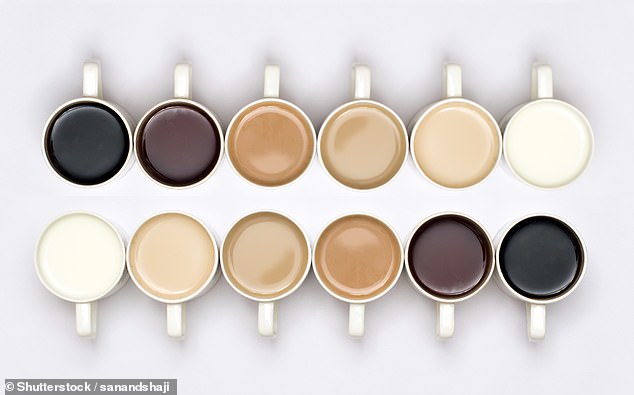Whether it’s at home or in the office, nothing seems to divide opinion quite like how much milk you put in a cup of tea.
Do you have it super milky, barely giving the tea leaves time to percolate?
Do you not bother with milk at all, leaving it a dark shade that could be mistaken for black coffee?
Or, do you have it somewhere in the middle – a robust shade of brown similar to peanut butter?
While this may seem like a frivolous choice, how you prepare this most beloved of British drinks can reveal a lot about your inner psyche.
Michelle Francl, a professor of chemistry at Bryn Mawr College in Pennsylvania, says milk preferences in tea could be linked to personality.
In fact, those who add less milk than others may be psychopaths who are secretly struggling with high levels of stress.
So next time you watch someone make tea, where’s what you may find out about them.

Whether it’s at home or in the office, nothing seems to divide opinion like how much milk you put in a cup of tea
Professor Francl cites a 2016 study by scientists in Austria, which investigated the link between a love for bitter tastes and personality traits.
The experts at the University of Innsbruck found that a preference for bitterness is positively associated with psychopathy and ‘everyday sadism’.
Psychopaths are impulsive, selfish, callous and remorseless, while sadists get pleasure from inflicting pain or humiliation on others.
So, a preference for tea with less milk – and in turn more bitterness – could be an indicator of these negative traits too, Professor Francl says.
In contrast, adding lots of milk will reduce the amount of an amino acid called L-theanine in the tea, known for its calming and relaxing effects.
Therefore, someone who chooses a pale, whiteish tea with lots of milk in may laugh in the face of stressful situations as they don’t need the effect of L-theanine.
‘Since L-theanine is a calming substance, perhaps seriously milky tea will be less calming,’ Professor Francl explains.
Generally, milk is added to tea because proteins in the milk, such as casein, mix with tea compounds to improve the palatability of the drink.


While this may seem like a frivolous choice, how you prepare this most beloved of British drinks can reveal a lot about your inner psyche
‘Milk is a pretty complicated mixture itself,’ said the academic, who last year made the controversial suggestion that salt should be added to tea as well.
‘Research suggests that molecules in the milk can bind molecules in the tea, changing the molecular profile of the tea.
‘In particular it can affect the bitterness of the tea, by binding the bitter alkaloids, making it less taste bitter.’
According to 2024 research commissioned by online marketplace Thortful, black tea drinkers want to be seen by others as someone who does not ‘play by the rules’.
Those who have it very strong with just the tiniest hint milk likely have ‘very strong opinions’ that they ‘absolutely long to share with anyone’.
Somewhere in between, not too light or too dark, is ‘highly confident’ and knows exactly what they like and ‘how to go about getting it’, while those who go for the rice pudding colour ‘may not be the sharpest spoon in the tea drawer’.
Other research suggests that most Brits like tea not too dark and not too light, but somewhere in the middle, similar to peanut butter in colour.

How do you drink yours? A recent study by Tombola created a ‘Tealux’ chart showing tea colours from ‘right’ to ‘wrong’, according to a survey of 1,000 Brits

A YouGov survey revealed that almost half (47 per cent) prefer a brew that’s exactly midway between a strong black tea and an ultra-weak cuppa with a liberal pouring of milk
In 2023, Tombola created a ‘Tealux’ chart showing tea colours from ‘right’ to ‘wrong’, according to a survey of 1,000 Brits.
And the ‘perfect brew’, opted for by 24.2 per cent of the respondents, is a robust, nutty brown colour, not too light and not too dark.
‘The worst brew’, meanwhile, with just 0.4 per cent of the votes, was not completely black but a very dark brown.
Similarly, a 2018 YouGov survey of nearly 1,600 people found 47 per cent of Brits prefer a medium brown shade, about midway between a strong black tea and an ultra-weak cuppa.
Another 19 per cent would rather have a slightly darker tea with less added milk – about the same colour as milk chocolate – and a further 14 per cent prefer their tea one shade more milky, about the same colour as rice pudding.
Only 18 per cent of respondents liked any other colour – which for most would be considered way too dark or too light.
This article was originally published by a www.dailymail.co.uk . Read the Original article here. .

